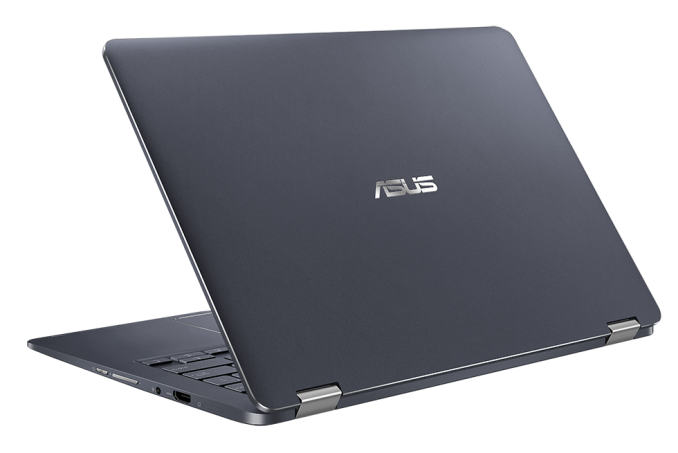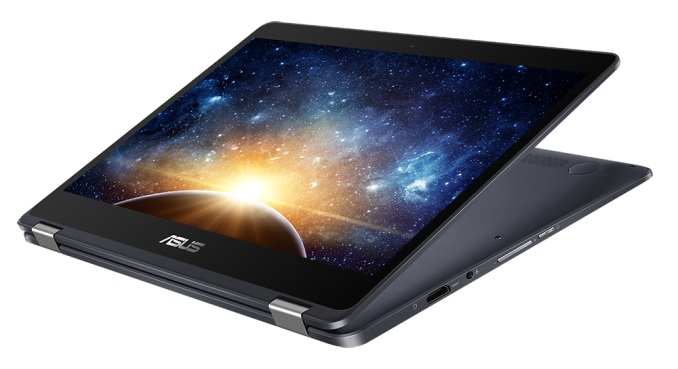ASUS Announces the NovaGo (TP370): A Snapdragon 835 based Windows 10 PC
by Ian Cutress on December 5, 2017 3:55 PM EST- Posted in
- Laptops
- Snapdragon
- Asus
- Qualcomm
- Notebooks
- Windows 10 S
- SD835

At the Qualcomm Snapdragon Technology Summit today, alongside Qualcomm officially announcing the Snapdragon 835 Mobile PC platform, several partners got up on stage to promote their upcoming wares. The main headline device was from ASUS. CEO Jerry Shen announced the ASUS NovaGo (TP370) as the world’s first Gigabit LTE capable laptop, supported by the SD835 chip and its inbuilt X16 LTE modem.
The key factor of these devices that ASUS (and Qualcomm) want to drive home is the always-on connectivity (provided by the built-in modem) as well as the battery life. To that end ASUS is listing the new NovaGo as having up to 22 hours of battery life and 30 days of modern standby. The idea is that the user can pick up the notebook in the morning and not need to charge it all day until they get home, or in the case of one speaker’s experience, charge it once a week. The battery is rated at 52 Wh.
On the connectivity front, ASUS has bundled the X16 LTE modem with enough hardware support for 4x Carrier Aggregation and 4x4 MIMO for up to gigabit LTE speeds, and 2x2 802.11ac for standard wireless connectivity. The LTE data flow can be accessed by eSIM or nanoSIM, allowing users to activate local data plans from the Windows Store immediately coming off the plane.
The base specifications have the device at 4GB DRAM and 64GB of UFS 2.0 storage, or there will be an upgraded model with 8GB of DRAM and 128GB of storage for an extra $200. ASUS lists the storage as capable of 1.4 Gbps, although it will be interesting to see how that translates when we get the devices on hand. Ports on the NovaGo include two USB 3.1 (5 Gbps) Type-A ports and an HDMI port, with a 3.5mm jack.
| ASUS NovaGo (TP370) | |||
| Specifications | |||
| SoC | Qualcomm Snapdragon 835 Mobile SoC 4 x Kryo 280 Performance (2.45 GHz) 4 x Kryo Efficiency (1.9 GHz) Adreno 540 GPU (710 MHz) |
||
| Operating System | Microsoft Windows 10 S | ||
| Display | 13.3-inch 1920x1080 IPS | ||
| DRAM | 4 GB | 8 GB | |
| Storage | 64 GB | 128 GB | 256 GB |
| Connectivity | Qualcomm Integrated X16 LTE Cat 16 Download: 1 Gbps Cat 13 Upload: 150 Mbps 2x2 802.11ac MU-MIMO Wi-Fi |
||
| I/O | 2 x USB 3.1 (5 Gbps) Type-A 1 x 3.5mm Audio Jack 1 x Combo Nano-SIM (tray) 1 x MicroSD Card Reader (up to 256 GB) 1 x HDMI 1 x DX-in |
||
| Speakers | 2 x Stereo with Smart Amp | ||
| Battery | 52 Wh Li-Po | ||
| Dimensions | 316.0 x 221.6 x 14.9 mm 1.39 kg |
||
| Price (US MSRP) | $599 | $799 | ? |
The OS will be Windows 10 S. This runs a version of Windows that relies mostly on the Store for the main applications but the system does perform binary translation (or similar) for 32-bit x86 applications. 64-bit x86 apps are a no-go, so for users that have their own software setups outside the Windows 10 store, it might get a little tricky (Qualcomm doesn’t see this as much of an issue). Applications like Office365 will have their own optimized versions for the SD835 Mobile PC devices.
The NovaGo is a full 360º hinge design, with a 14.9mm z-height and weighing in at 1.39 kg with a sandblasted Sky Grey finish. The 13.3-inch 1080p NanoEdge display has a 78% screen to body ratio and supports 10-point multitouch as well as ASUS Pen support with 1024 pressure levels. ASUS also cites 178º viewing angles and 100% sRGB gamut, with ASUS Eye Care and Tru2Life video technology.
Arrangements are already in place with T-Mobile, Sprint, Verizon, TIM, China Telecom and Chunghwa Telecom, while other providers in the main first wave of countries (US, UK, Italy, France, Germany, China, Taiwan) are in discussions with ASUS.
Pricing for the device gives the base 4/64 model as $599, and the upgraded 8/128 model as $799. That puts it in the realm of a large number of good Intel-based clamshells, including those from ASUS, although without always-on connectivity.
Availability will be region dependant, though we did not get any other information. ASUS say they are the first, and with a bunch of devices coming at CES, it would be before the others (HP says Spring 2018).












36 Comments
View All Comments
HStewart - Tuesday, December 5, 2017 - link
I predict a user nightmare is coming with these devices. First of all non technical will see the device as low power device with long battery life, purchase this device - and expecting to run windows x86 application including games - especially from ASUS and then first of all Windows 10 S will not allow the application and if it does run - it will run significantly slower.This could be Windows RT all over again. Microsoft has been trying to make Windows multi-platform for decades - the original Windows NT was planned to be this which Windows 7, Windows 8 and Windows 10 have all be built on top of. Windows NT could run Risc processor and even the Dec Alpha.
On the other hand if all you need is Office and Internet - this device will be good fit - no wonder they are including LTE modem in it. I wonder how much that 1Gb Modem adds to the cost.
skavi - Tuesday, December 5, 2017 - link
It doesn't, because it's part of the 835.Morawka - Tuesday, December 5, 2017 - link
adds cost none-the-less. Qualcomm charges a percentage of MSRP for it's LTE modems. Other costs such as 4X antenna's for the MIMO functionality add significant cost because only certain parts of the laptop can be used for antenna mounting.Martijn ter Haar - Tuesday, December 5, 2017 - link
I think this will be mainly a business oriented market. Instead of having to buy a phone and a laptop or tablet for your drivers, nurses and salesmen, you can now give them an ARM laptop with a Bluetooth headset. No separate phone necessary and it can run the specific enterprise applications, which is often old Windows or even DOS software.lazarpandar - Tuesday, December 5, 2017 - link
Your statements imply a huge lack of understanding of the product. It can run x86 applications through emulation. Windows 10 S is upgradeable to Windows 10 (pro?) in the first month or so, as skavi said the modem is part of the SoC already.Games, it's true users would need to drop that expectation.
Santoval - Tuesday, December 5, 2017 - link
I am not quite sure if the binary translation between ARM and x86 works for both Windows S and Windows 10 Pro, at this point anyway. So while the upgrade to Win 10 Pro (for $49) is possible for x86 devices it might not be possible for ARM devices.ikjadoon - Wednesday, December 6, 2017 - link
I think you'll hear these "non-technical" people on /r/PCMR and Anandtech comment threads, but not in real life. How many normal consumers buy a laptop to play games on it?It won't be significantly slower--Qualcomm's benchmarks and demos attest to that. We'll wait on benches, but imagining it's "already a shit show" is too much "the sky is falling".
Yes. Office. Browsing. You have hit about 85% of a consumers' needs. Congratulations.
numberlen - Thursday, December 7, 2017 - link
Even if just talking Office and browsing, using formula-heavy spreadsheets, or editing long documents with images and style markups will require a certain amount of graphics and processing power. Not gaming powerful, but enough that Atom equivalents don't cut it, especially not when also running a browser with a few script-heavy tabs.Besides, business people aren't price sensitive at all, and they'll be probably going for the Ultrabooks with those 4.5W Intel processors. And I'm not sure that this offering will stack up.
But sure, let's wait for the benchmarks.
HStewart - Tuesday, December 5, 2017 - link
One concern about this laptop - is Qualcomm creating a monopoly and this is not related to Microsoft but the 1Gb LTE Modem - which is only available on Qualcomm SOC's according to the following article.https://arstechnica.com/gadgets/2016/02/qualcomm-p...
the big question will they allow other CPU platforms access to this technology - and if they do will they only allow certain platforms.
shabby - Tuesday, December 5, 2017 - link
Amd just announced a laptop with Ryzen and a qualcomm lte modem so all is well.